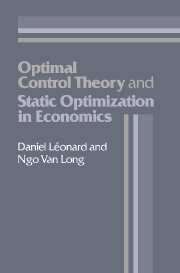Book contents
- Frontmatter
- Contents
- Preface
- 1 Static optimization
- 2 Ordinary differential equations
- 3 Introduction to dynamic optimization
- 4 The maximum principle
- 5 The calculus of variations and dynamic programming
- 6 The general constrained control problem
- 7 Endpoint constraints and transversality conditions
- 8 Discontinuities in the optimal controls
- 9 Infinite-horizon problems
- 10 Three special topics
- Bibliography
- Index
7 - Endpoint constraints and transversality conditions
Published online by Cambridge University Press: 05 June 2012
- Frontmatter
- Contents
- Preface
- 1 Static optimization
- 2 Ordinary differential equations
- 3 Introduction to dynamic optimization
- 4 The maximum principle
- 5 The calculus of variations and dynamic programming
- 6 The general constrained control problem
- 7 Endpoint constraints and transversality conditions
- 8 Discontinuities in the optimal controls
- 9 Infinite-horizon problems
- 10 Three special topics
- Bibliography
- Index
Summary
In Chapters 4 and 6 we assumed that the time horizon T, the initial values of state variables, si0, and their terminal values siT were exogenously specified. Obviously these are very restrictive assumptions. In many economic problems we want to allow some of these values to be determined endogenously (subject to constraints). For example, the optimal consumption problem (Example 6.4.1) may be modified to allow the planner to select the value of the terminal stock s(T), subject only to some constraint such that s(T) may not be less than a certain lower bound s, or even to select the economy's doomsday T after which all activities cease. Obviously, when s(T) or T is not fixed, we need additional necessary conditions to determine the new unknown (s*(T) or T*); these conditions are called the transversality conditions.
We shall look at various cases, beginning with the simplest. Section 7.8 contains a general statement synthesizing the various transversality conditions. Because there are many kinds of boundary conditions, there are also many kinds of transversality conditions. This array of special cases sometimes appears formidable to students of optimal control theory. For this reason a summary table is provided in Section 7.10. The table lists various features of control problems, and for each one gives the associated transversality condition. If a problem has several of these features, all corresponding transversality conditions apply.
Each of the following sections presents one type of problem and derives the associated transversality condition.
- Type
- Chapter
- Information
- Optimal Control Theory and Static Optimization in Economics , pp. 221 - 262Publisher: Cambridge University PressPrint publication year: 1992



